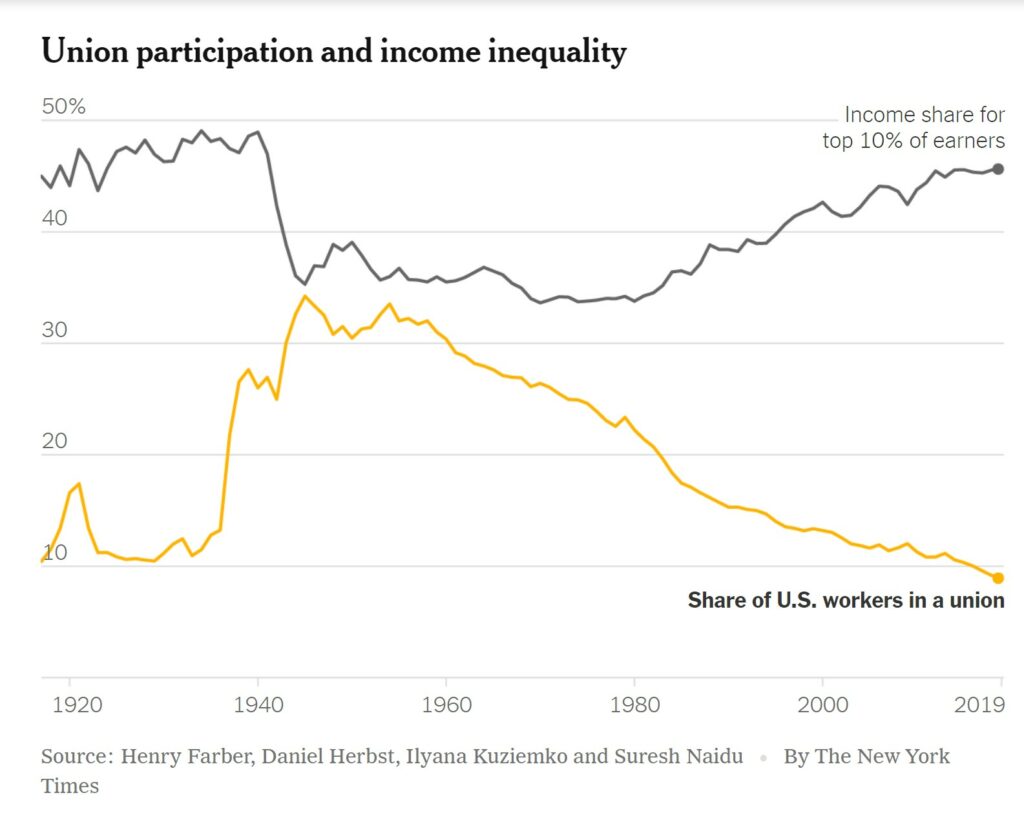The action by the United Auto Workers is part of a burst of labor activism attempting to reverse a decades-long trend. The trend as noted in the following graph. How the Latest Labor Strikes Are Attempting to Reverse Decades-Long Trends, The New York Times, David Leonhardt. (If you are having issues linking to this article to read the rest of it, you can subscribe to NYT and can read a few articles for free.) Some of the story (you can read the rest on the NYT) . . . The current burst of labor activism, in the auto industry, Hollywood, Amazon warehouses, Starbucks stores and elsewhere, is an attempt to reverse these trends. The United Auto Workers, for example, agreed to large pay cuts for new workers when the industry was near
Topics:
Bill Haskell considers the following as important: 2023, Hot Topics, Strike, United Auto Workers Union, US/Global Economics
This could be interesting, too:
NewDealdemocrat writes JOLTS revisions from Yesterday’s Report
Joel Eissenberg writes No Invading Allies Act
Joel Eissenberg writes How Tesla makes money
NewDealdemocrat writes January JOLTS report: monthly increases, but significant downward revisions to 2024
The action by the United Auto Workers is part of a burst of labor activism attempting to reverse a decades-long trend. The trend as noted in the following graph.
How the Latest Labor Strikes Are Attempting to Reverse Decades-Long Trends, The New York Times, David Leonhardt.
(If you are having issues linking to this article to read the rest of it, you can subscribe to NYT and can read a few articles for free.)
Some of the story (you can read the rest on the NYT) . . .
The current burst of labor activism, in the auto industry, Hollywood, Amazon warehouses, Starbucks stores and elsewhere, is an attempt to reverse these trends. The United Auto Workers, for example, agreed to large pay cuts for new workers when the industry was near collapse during the financial crisis almost 15 years ago. Since then, Detroit’s Big Three consisting of General Motors, Ford and Chrysler (now owned by Stellantis, a Netherlands-based company) have recovered and earning large profits. However, workers or Labor’s income has not rebounded so well.
Union leaders are now asking for a 36 percent wage increase over four years, to match the similar recent pay increase for top executives. The union also wants pay to rise automatically with inflation in the future, as it did before the financial crisis. Without such cost-of-living increases, inflation causes de facto pay declines every year.
I want to emphasize the broader importance of unions doesn’t mean that all their demands are reasonable. Sometimes, unions really do make self-defeating demands. The auto industry is a case study. As Japanese and German companies won over American customers in the 1970s and 1980s. Detroit’s unions (along with the industry’s top executives) were slow to recognize the threat and continued insisting on wages and work rules that contributed to the Big Three’s decline.*
*My comment . . . The graph is great. It clearly emphasizes what those making $200,000 and above (the upper 10% -2020) are making in income or ~46% of total pre-tax income. Pretty hefty!
Then David makes a reversal in the last paragraph (above) he writes.
The auto industry is a case study. As Japanese and German companies won over American customers in the 1970s and 1980s.
Fifty-year-old David was just a kid in the seventies playing with Tonka trucks and other kids toys. in the late eighties he maybe was just starting to realize he could get a license and drive a car too. In 71 I left the service got married and bought a Datsun 510 to take me back and forth to college and where I worked. A boxy car with a carbureted 1.8 litre engine and a three speed Borg Warner transmission. It served me well during the oil embargo too.
The American cars being built in the late sixties, seventies, and into the eighties were poorly designed, rusted quickly, and had issues with engines, transmissions, etc. The foreign cars coming to the US like my Datsun 510 (Nissan) were built far better and not as flashy. Early obsolescence designed into US vehicles had nothing to do with unions or their pay. These were design issues. Foreign cars were designed better and were consequently built better than US cars then. That was the practice of US automakers well before abundant foreign cars hit the market. Unions built them like they were designed to be built. No amount of cuts in Labor costs would have made a difference in Quality. US automakers were not interested in Quality as they could sell more cars then.
Falling Auto Worker Wages and Increasing CEO Pay . . . Angry Bear.
Should we care about the Big 3? Angry Bear.

